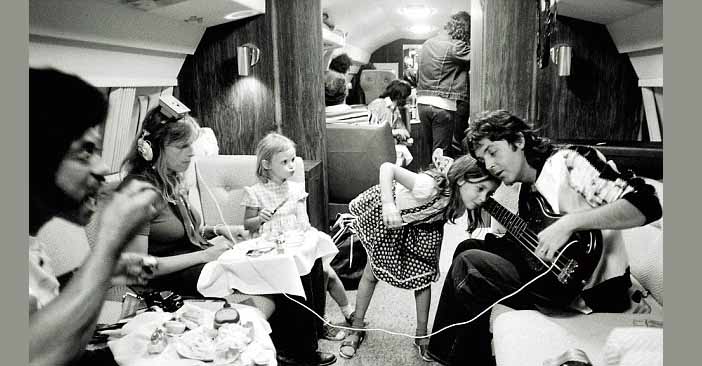
From “Man on the Run” by Tom Doyle,
He wheeled a stove-sized four-track machine from Abbey Road into his home and began to play, in the childlike sense of the word. "It was very liberating," he says. He was able to record entirely alone thanks to a device built by an Abbey Road technician that allowed him to plug directly into the back of the tape machine.
Homemade and handmade, the resulting album, "McCartney," was less the grand launch of his solo career and more an insight into McCartney's creative practices. But before the listening public had the opportunity to make up their minds about the record, it was to provoke an almighty ruckus.
Paul McCartney on His Not So Silly Love Songs
Weeks before the album's April 17 release, Ringo Starr showed up at McCartney's London address with a letter handwritten by Lennon and co-signed by Harrison. The Beatles' "Let It Be" was to be released April 24, and the letter notified McCartney that because of concern over the proximity of these dates, Lennon and Harrison had told EMI to hold the release of "McCartney" until June 4. After reading the letter, a furious McCartney threw Starr out of his house. "Everyone, to my mind, was completely treating me like dirt," says McCartney. "And I said, ‘No way, man. Get out.' "
That was the moment when McCartney finally gave up on The Beatles. He wouldn't budge on the street date and, ultimately, "Let It Be" was pushed to a May 8 release. When it came time to promote his solo album, McCartney sidestepped face-to-face encounters by inserting a sulky press release-cum-self interview with review copies of the album. Was he planning any new records with The Beatles? No. Did he see himself writing songs with Lennon in the future? No. What were his plans now? "My only plan is to grow up," he wrote.
The news exploded across the front pages of the world's newspapers. The Daily Mirror in Britain, on the morning of April 10, 1970, was the first to break the story of the band's split, with the unfussy words "Paul Quits the Beatles." Lost in the roar was the fact that at no point in the "interview" had McCartney actually stated that he was walking out on the band.
In the fallout, the McCartneys once again ran away to Scotland, and, on a bright, cold December day, McCartney stood high on a hill overlooking Skeroblin Loch at the end of a long walk and a deep conversation with his attorney father-in-law, Lee Eastman. "We'd been searching our souls," says McCartney. He had decided that it was time to legally kill The Beatles.
A week into January, drummer Denny Seiwell turned up for a nameless demo session at a seedy address at 43rd Street between Ninth and 10th Avenues in Manhattan. The building looked burned out and appeared to have no electricity. Directed to the damp, dilapidated basement by the doorman, he found Paul and Linda McCartney, sitting beside a battered old hired drum kit.
"They said, ‘Do you mind playing for us?' " says Seiwell. "And I just went into Ringo on the tom-toms."
Seiwell got the gig, and with the addition of sought-after session guitarist David Spinozza, the loose, three-handed recording sessions for what would become McCartney's second solo album, "Ram," began in New York.
Across the Atlantic there was the tangled mess of The Beatles' legal affairs. On the final day of 1970, McCartney had filed to dissolve the Beatles & Company, and he returned to London in February to take part in the 12-day court hearing. He was back in New York on March 12, 1971 when a London High Court judge granted McCartney's request for a receiver to oversee the band's interests "pending a permanent fix." McCartney had unequivocally won the first crucial round in the battle, even if he now found himself hated by the press, the fans and the other band members. The day the verdict was announced, according to the eyewitness accounts, Lennon, Starr and Harrison turned up at McCartney's Cavendish Avenue home in Lennon's white Rolls Royce. Lennon emerged from the car with two bricks, scaled the wall and smashed McCartney's windows.
McCartney was back in the United States at that point and three days after the end of the court case, flew to Los Angeles to oversee the mixing of "Ram." Whereas the New York leg of the album had been cleanly marshaled, the L.A. sessions were fueled by dope. McCartney would usually arrive in midafternoon, spark up a joint and then tinker endlessly.
The result was something of a marvel. The true successor to The Beatles' Abbey Road in its baroque detail and flights of imagination, "Ram" was variously funny, daft, touching and knowing. The unlikely U.S. No. 1 hit "Uncle Albert/Admiral Halsey" spotlighted the new McCartney method: trippy sentimentality gives way to rain and vocally impersonated ringing telephone effects before restlessly tempo-shifting upward through its lengthy coda."Ram" also seemed to be carefully mined with lyrical digs at Lennon and the other Beatles. "Too Many People" was directed squarely at the "preaching practices" of Lennon and his wife, Yoko Ono. "I felt that was true of what was going on," says McCartney. " ‘Do this, do that; do this, do that.' "The album made it only to No. 2 in the United States, where McCartney had reached No. 1. And critics on both sides of the Atlantic were unkind, verging on brutal. Rolling Stone loftily claimed, "'Ram' represents the nadir in the decomposition of 1960s rock thus far."
